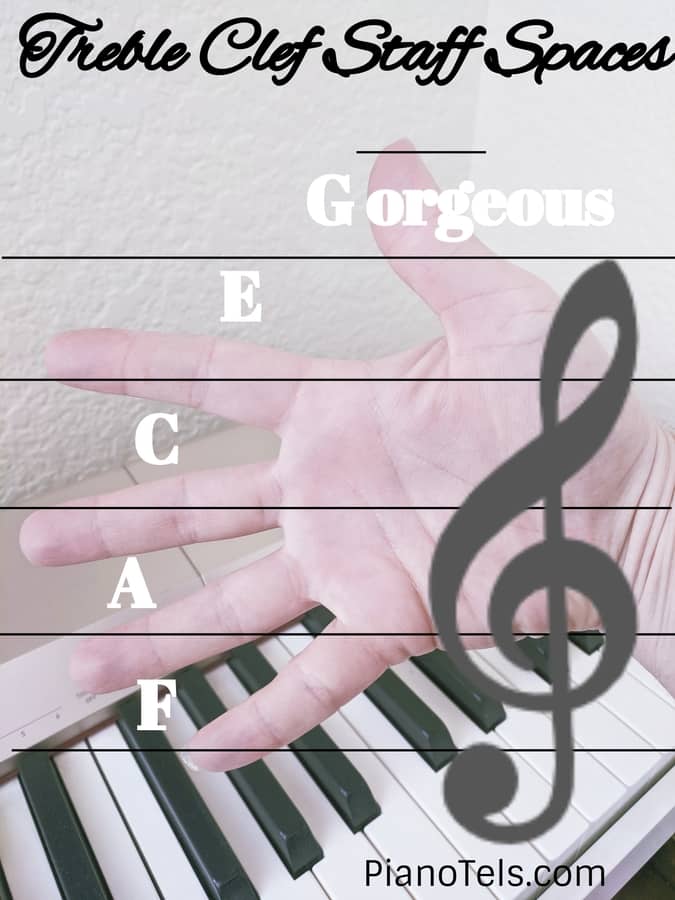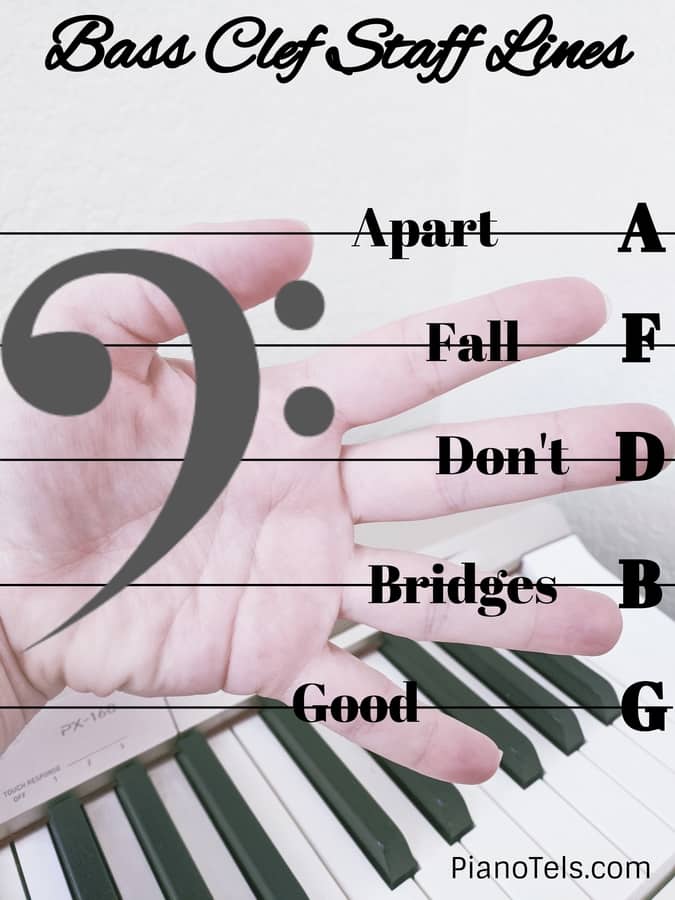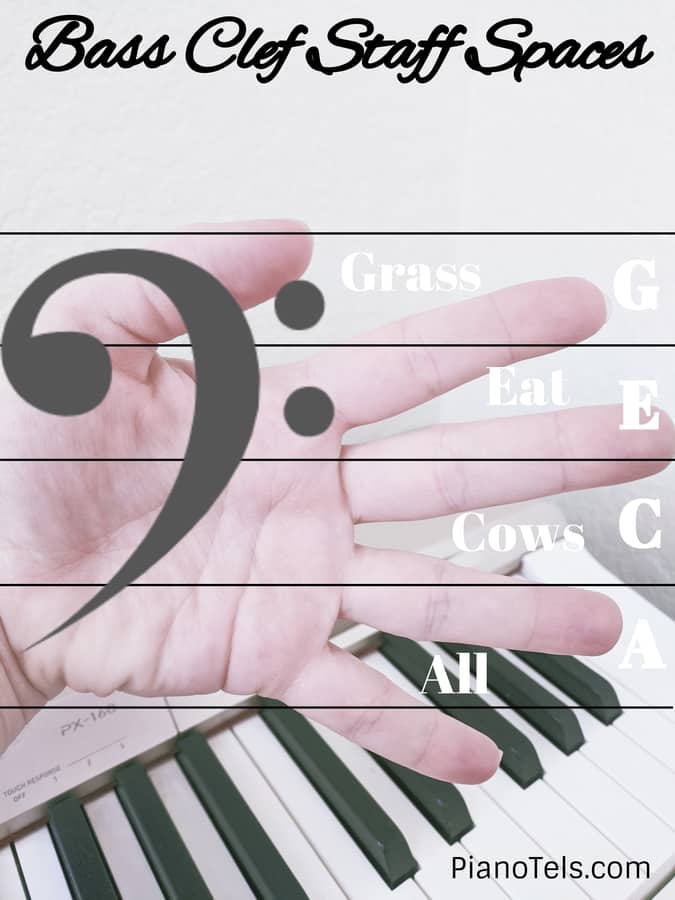One of the best (and fun) ways to remember the musical staff is to use your own hand! When my kids (even my preschooler) can name off all of the treble and bass clef lines and spaces, you know its full proof! But what makes this so much easier to remember and why does my preschooler even get it?
Random letters would be hard for the brain to remember, which is why an acronym or a mnemonic works well for memorizing the lines and spaces. If your brain can make connections to things it already knows, it is much easier to remember. They call those connections in the brain synapses. As many synapses as you can build, the easier to remember!
You can also build stronger synapses as you use your body. When you can use as many of your senses as possible, you build more and stronger synapses. You will be able to remember even better when you use your hand, use a mnemonic or acronym to represent the treble and bass clefs, point with the other hand as you say it, speak out loud, and visualize it. You get that down, and you won’t forget it!
In these illustrations, the hand represents the staff. The right hand represents the treble clef, while the left hand represents the bass clef. Each finger represents one line on the staff. Each space between each finger represents a space on the staff. As such, a staff has five lines and four spaces. Let’s take a closer look at each of the clefs and see how it works.
Treble Clef Staff Lines and an Easy Way to Remember
The right hand represents the treble clef. In piano, the treble clef is most often played by the right hand. So, it’s a good idea to get into the habit of using the right hand to represent the treble clef as you memorize the lines and spaces.
With your thumb pointing up, use your left hand to point to the right hand starting with the little (or pinky) finger. Say, “Every Good Boy Deserves Fudge Always” as you point to each finger.
Bonus: We don’t have six fingers, but the last word, “always” is nice to include as an extra ledger line. If that just confuses you, just ignore it.

Treble Clef Staff Spaces and an Easy Way to Remember
The treble clef spaces make a great acronym. This is probably the easiest one to remember of them all! If you are dealing with young kids, I find the most challenging thing about this one is that they sometimes don’t know how to spell “face”. So make sure they know how to spell it before you start drilling it into them. I say that from experience, lol! My poor daughter thought it was an “s” instead of a “c”. Easy to remedy, but I could have saved her some heartache if I had caught it sooner.
With your thumb pointing up, use your left hand to point to the right hand starting with the space between the little (or pinky) finger and the fourth (or ring) finger. Spell “F-A-C-E” as you point between each finger.
Bonus: at the top, above the thumb, you can say, “What’s your FACE? Gorgeous! Gorgeous!” Kind of a fun addition to the traditional saying, and it helps to remember that there is a G in that space.
Another tip to help remember: SPACE rhymes with FACE. Treble clef spaces are f-a-c-e.

Bass Clef Staff Lines and an Easy Way to Remember
The left hand represents the bass clef. In piano, the bass clef is most often played by the left hand. So, it’s a good idea to get into the habit of using the left hand to represent the bass clef as you memorize the lines and spaces.
With your thumb pointing up, use your right hand to point to the left hand starting with the little (or pinky) finger. Say, “Good Bridges Don’t Fall Apart” as you point to each finger.
Now, since I like working with kids, and since I am all about engaging the brain in as many ways as possible, I love to do a little activity with this one. I would suggest it even for adults. I promise, it will help it to stick in the brain albeit you may feel a little silly. Just imagine it, if nothing else!
While doing the activity, London Bridges Falling Down, replace the song with the words, “Good Bridges Don’t Fall Apart”. It should go like this:
“Good bridges don’t fall apart, don’t fall apart, don’t fall apart. Good bridges don’t fall apart, in the bass clef!”
Two kids put their hands together and form a bridge. The other kids go under the bridge while singing the song, Good Bridges Don’t Fall Apart. Take turns being the bridge and skipping under it.

Bass Clef Staff Spaces and an Easy Way to Remember
The left hand represents the bass clef. In piano, the bass clef is most often played by the left hand. So, it’s a good idea to get into the habit of using the left hand to represent the bass clef as you memorize the lines and spaces.
With your thumb pointing up, use your right hand to point to the left hand starting with the space between the little (or pinky) finger and the fourth (or ring) finger. The mnemonic that goes with the bass clef spaces is, “All Cows Eat Grass”. You can say this as you point to the space between each finger.
Bonus: although the illustration doesn’t say this, because I didn’t want to risk offending anyone, you could, as an option, include the space above the thumb in this mnemonic. You could say, “All Cows Eat Grass, then they Burp.” I bolded all the letters that follow the names of the staff, so hopefully you understand what I mean. The boys love this addition, but I could see how you may not want to include it.

Once you have wrapped your head, or should I say your hand, around these concepts and these illustrations, now you will want to practice! At first, it may seem difficult, but I promise you will get the hang of it! My six year old can whip out flashcards almost as fast as I can!
Fun Ideas for Practicing Your Note Names
The first thing you will want to do, is get a hold of some practice music note flashcards. There are options online of free flashcards for you to print from your own home, but you may want to consider buying a set of these music flashcards, since it will probably cost you less in printing and considerably less time in preparing them.
You can use your flashcards to just whip through them as you quiz yourself. Or you can practice them with some games. You will get to know these notes before you know it with a little bit of practice and perseverance. Here’s a couple of games you could try out:
Play Word Search. Using the flashcards to represent each name of the note, find words such as: bag, baggage, face, be, cab, bead, fade, deed, bee, ace, babe, cafe, facade, fed, dad, faded, gag, bed, bad, age, cab, cabbage, aged, bade, badge, beef, beg, cage, dab, dead, edge, egg, feed. Find more easier and more advanced version of the word search game.
Musical Note Spoons. You can become really familiar with notes and their placement, if you play a round of Musical Note Spoons. This can get challenging, but it helps you to be able to recognize the notes by sight. This becomes a valuable skill in music at it increases sight reading!
Musical Pit! Musical Pit is based off of the popular game of Pit – an exciting, fast paced, competitive game that just about anybody can play!
Tel loves her life as a piano player, a piano teacher, and a mom. Amid piano blogging, piano teaching, and piano playing, she loves a chance to fit in a good exercise class, volunteer at her kids’ school and at her church, and go on long dates with her husband. Full bio at About Tel.



thanks for the information